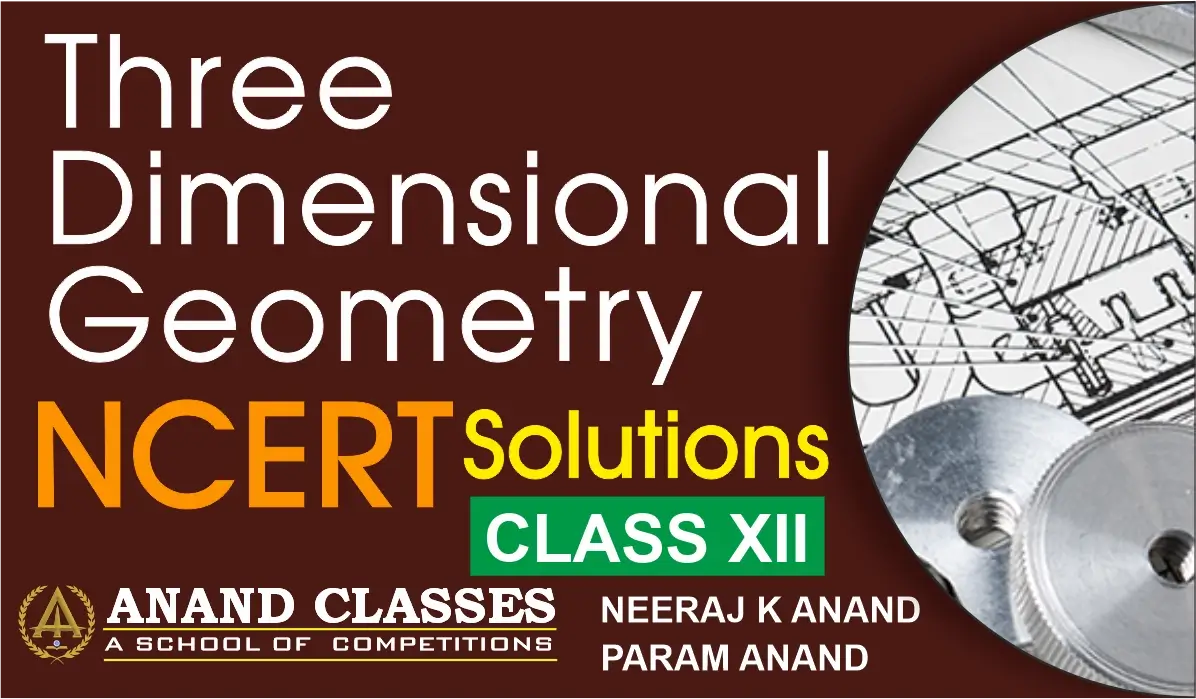Anand Classes offers expertly crafted NCERT Solutions for Exercise 11.1 of Chapter 11 – Three Dimensional Geometry for Class 12 Maths, helping students understand direction cosines, ratios, and 3D geometry concepts with ease. These notes include detailed explanations and solved examples to support effective exam preparation. Click the print button to download study material and notes.
Access NCERT Solutions for Exercise 11.1 of Chapter 11 – Three Dimensional Geometry for Class 12 Maths
NCERT Question 1 : If a line makes angles $90^\circ$, $135^\circ$, and $45^\circ$ with the $x$, $y$, and $z$ axes respectively, find its direction cosines.
Solution
Let the direction cosines of the line be $l, m, n$.
$$ l = \cos 90^\circ = 0 $$
$$ m = \cos 135^\circ = -\frac{1}{\sqrt{2}} $$
$$ n = \cos 45^\circ = \frac{1}{\sqrt{2}} $$
Therefore, the direction cosines of the line are:
$$ 0, -\frac{1}{\sqrt{2}}, \frac{1}{\sqrt{2}} $$
Strengthen your understanding of vectors with Anand Classes—ideal for CBSE, ISC, and JEE preparation with clear, exam-focused explanations.
NCERT Question 2 : Find the direction cosines of a line which makes equal angles with the coordinate axes.
Solution
Let the direction cosines of the line be $l, m, n$ and let it make the same angle $\alpha$ with each coordinate axis.
Thus,
$$ l = \cos \alpha,\quad m = \cos \alpha,\quad n = \cos \alpha $$
Using the identity:
$$ l^2 + m^2 + n^2 = 1 $$
Substitute values:
$$ \cos^2 \alpha + \cos^2 \alpha + \cos^2 \alpha = 1 $$
$$ 3\cos^2 \alpha = 1 $$
$$ \cos^2 \alpha = \frac{1}{3} $$
$$ \cos \alpha = \pm\frac{1}{\sqrt{3}} $$
Therefore, the direction cosines of a line equally inclined to all coordinate axes are:
$$ \pm\frac{1}{\sqrt{3}}, \pm\frac{1}{\sqrt{3}}, \pm\frac{1}{\sqrt{3}} $$
Enhance your vector geometry preparation with Anand Classes—your trusted source for clear, concise explanations ideal for CBSE, ISC, and JEE aspirants.
NCERT Question 3 : If a line has the direction ratios
$<-18, 12, -4>$, find its direction cosines.
Solution
Given direction ratios:
$$ <-18, 12, -4> $$
The direction cosines are obtained by dividing each direction ratio by the magnitude:
$$ \sqrt{(-18)^2 + 12^2 + (-4)^2} =\sqrt{324 + 144 + 16}=\sqrt{484}=22$$
Thus, the direction cosines are:
$$ <\frac{-18}{22}, \frac{12}{22}, \frac{-4}{22} >$$
Simplifying each term:
$$ <-\frac{9}{11}, \frac{6}{11}, -\frac{2}{11}> $$
Therefore, the direction cosines of the line are:
$$ <-\frac{9}{11}, \frac{6}{11}, -\frac{2}{11}> $$
Build a stronger foundation in vectors and geometry with high-quality study material from Anand Classes, ideal for JEE, NEET, and CBSE learners aiming for top results.
NCERT Question 4 : Show that the points $(2, 3, 4), (-1, -2, 1), (5, 8, 7)$ are collinear.
Solution
Let the points be:
- $A(2, 3, 4)$
- $B(-1, -2, 1)$
- $C(5, 8, 7)$
Direction ratios of $AB$
Using
$$ <(x_2 – x_1, y_2 – y_1, z_2 – z_1)> $$
Compute $AB$:
$$ <(-1 – 2, -2 – 3, 1 – 4)> $$
$$ \overrightarrow{AB}=<-3, -5, -3> $$
Direction ratios of (BC)
Compute (BC):
$$ <5 – (-1), 8 – (-2), 7 – 1> $$
$$\overrightarrow{BC}= <6, 10, 6> $$
Check proportionality
Observe:
$$ 6, 10, 6 = -2(-3, -5, -3) $$
$$\overrightarrow{BC}= -2 \overrightarrow{AB}$$
Thus, the direction ratios of $BC$ are (-2) times those of $AB$, so they are proportional.
Hence, $AB$ is parallel to $BC$. Since $B$ is common to both, the points $(A, B, C)$ are collinear.
Strengthen your vector geometry concepts with comprehensive notes from Anand Classes, designed for CBSE, JEE, and competitive exams to boost your score.
NCERT Question 5 : Find the direction cosines of the sides of the triangle whose vertices are $(3,5,-4), (-1,1,2), (-5,-5,-2)$.
Solution
Let the vertices of $\triangle ABC$ be:
- $A(3, 5, -4)$
- $B(-1, 1, 2)$
- $C(-5, -5, -2)$
Direction Cosines of AB
Step 1: Direction ratios of (AB)
$$ AB = (-1 – 3, 1 – 5, 2 – (-4)) $$
$$ AB = (-4, -4, 6) $$
Step 2: Magnitude of (AB)
$$ \sqrt{(-4)^2 + (-4)^2 + 6^2} = \sqrt{16 + 16 + 36} $$
$$ = \sqrt{68} = 2\sqrt{17} $$
Step 3: Direction cosines of (AB)
$$ \left( \frac{-4}{2\sqrt{17}}, \frac{-4}{2\sqrt{17}}, \frac{6}{2\sqrt{17}} \right) $$
Simplifying:
$$ \left( \frac{-2}{\sqrt{17}}, \frac{-2}{\sqrt{17}}, \frac{3}{\sqrt{17}} \right) $$
Direction Cosines of BC
Step 1: Direction ratios of (BC)
$$ BC = (-5 – (-1), -5 – 1, -2 – 2) $$
$$ BC = (-4, -6, -4) $$
Step 2: Magnitude of (BC)
$$ \sqrt{(-4)^2 + (-6)^2 + (-4)^2} = \sqrt{16 + 36 + 16} $$
$$ = \sqrt{68} = 2\sqrt{17} $$
Step 3: Direction cosines of (BC)
$$ \left( \frac{-4}{2\sqrt{17}}, \frac{-6}{2\sqrt{17}}, \frac{-4}{2\sqrt{17}} \right) $$
Direction Cosines of CA
Step 1: Direction ratios of (CA)
$$ CA = (3 – (-5), 5 – (-5), -4 – (-2)) $$
$$ CA = (8, 10, -2) $$
Step 2: Magnitude of (CA)
$$ \sqrt{8^2 + 10^2 + (-2)^2} = \sqrt{64 + 100 + 4} $$
$$ = \sqrt{168} = 2\sqrt{42} $$
Step 3: Direction cosines of (CA)
$$ \left( \frac{8}{2\sqrt{42}}, \frac{10}{2\sqrt{42}}, \frac{-2}{2\sqrt{42}} \right) $$
Simplifying:
$$ \left( \frac{4}{\sqrt{42}}, \frac{5}{\sqrt{42}}, \frac{-1}{\sqrt{42}} \right) $$
Boost your understanding of 3D geometry with detailed, exam-focused study material from Anand Classes, perfect for CBSE and JEE aspirants aiming for top results.

